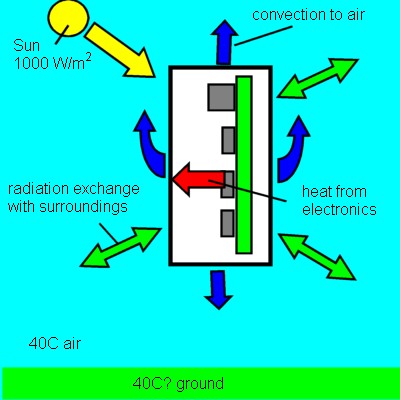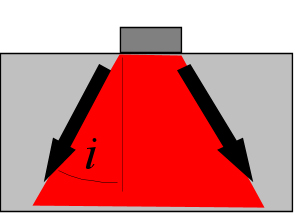Answers to those Doggone Thermal Design Questions
By Tony Kordyban
Copyright by Tony Kordyban 2003
Dear Tony,
Our electronics go in a box that can be mounted on the outside of a building, or even the mast of a ship at sea. The customer requirement says we must prove by testing that it can work when the outside air is 40 degrees C, the wind is calm, and the sun is beating down with an intensity of 1,000 Watts per square meter.
I think our product can meet this requirement. But how can we prove it with a test? Our environmental chamber can control the air temperature and the relative humidity, but how do we duplicate the solar load? We could take our box toAlbuquerquein July, but the odds of getting the right solar intensity, air temperature and wind speed all at the same time seem pretty long.
Can we just increase the air temperature in our chamber to simulate the extra heat load from the sun? How many degrees of ambient temperature are the equivalent of 1,000 Watts per square foot?
Overworked from Beaverton
Dear Beav,
You, like many in the outdoor electronics business, are the victim of an untestable test requirement.
The requirement seems to be a fairly clear. But it has been left entirely up to you to figure out how to conduct the test. There is a reason your customer left it up to you. They don’t know how to do it either.
 This is the thermal environment that your box will see, according to the worst case requirements. Your box is suspended on a pole or the side of a building, exposed to the sun and the air. The electronics inside your box generate some amount of heat that has to get out. I assume the box is sealed to keep out moisture and insects, so the only way for the heat to get out is by heating up the walls of the box, and then that heat goes to the environment by convection and radiation. The temperature of the electronics is tied to the temperature of the walls of the box. The hotter the walls end up, the hotter the electronics get.
This is the thermal environment that your box will see, according to the worst case requirements. Your box is suspended on a pole or the side of a building, exposed to the sun and the air. The electronics inside your box generate some amount of heat that has to get out. I assume the box is sealed to keep out moisture and insects, so the only way for the heat to get out is by heating up the walls of the box, and then that heat goes to the environment by convection and radiation. The temperature of the electronics is tied to the temperature of the walls of the box. The hotter the walls end up, the hotter the electronics get.
The walls of the box see heat coming in and going out in a variety of ways. There is the solar radiation, at 1,000 W/m2. That can be a lot of heat. But if you have done your homework designing your box, perhaps most of it never even gets absorbed by the walls. If you coated the surfaces white paint with low absorptivity in the solar spectrum, or made it highly reflective, or made it a double-wall construction so that the outer wall acts as a parasol for the inner wall, then perhaps only a small fraction of the solar radiation gets absorbed.
Then we need to consider that the walls of the box are hotter than the surrounding air, so there will be convective heat transfer. Even if there is no wind, there is natural convection. The bigger the temperature difference between the box wall and the air, the more natural convection there will be.
Again, because the walls of the box are hotter than the surroundings, it is possible that they can give off radiation to the surroundings. They can even radiate to the portion of the sky not occupied by the sun (the sun looks pretty much a point source, so you can assume radiation to the whole sky, at least what is not obstructed by the surroundings.) Surfaces like grass and trees are near air temperature, so the box radiate to them. Surfaces like asphalt parking lots may actually be hotter than the air, or reflect the sun directly toward the box, and add more radiation. That is why I show a double-ended arrow for the exchange of radiation with the surroundings. There is no way to tell if radiation will be a net loss or gain from the surroundings unless you know what they are.
Let me sum up the situation: the box wall temperature depends on a lot of complicated heat transfer going in and out by different mechanisms at the same time, and a lot depends on the radiation characteristics of your box design.
 But this is the way you propose to test the thermal performance of your box.
But this is the way you propose to test the thermal performance of your box.
You will put it in an environmental chamber that has no radiation load. To compensate for the missing solar load, you will increase the ambient temperature higher than the required 40C. Now all you need to know is how high to set the ambient so that this picture looks just like the previous one. Should it be 65C? 70C? 100C? Or maybe it should be adjusted for the surface area?
There are a couple of reasons why this approach should never be accepted as proof that your box meets the customer requirement.
1. The convection is wrong. Every environmental chamber has a robust circulating fan to keep the air temperature uniform. This is hardly “still air”.
2. The radiation is wrong. You are not testing the most important feature of the box the feature that might make it work in the most most intense solar radiation — the ability of the walls to absorb or reflect solar radiation! Since there is practically no radiation exchange in this test (chamber walls tend to be bare stainless steel with low emissivity), this test proves nothing about how it will perform in direct sunlight.
Let’s say you did some pretty good calculations, either by hand, or using any of the numerical simulation tools available, and you determined that your box wall would be 25 degrees C hotter than the air, based on the radiation properties of the box coating, and some assumptions about the surroundings. Can you then just boost the ambient in your environmental chamber until the box wall temperature hits 65C, measure your component temperatures, and say that you have proved it meets the customer requirement?
I don’t think so. You have proved that the electronics work when the box wall temperature is 65C. But you haven’t proven anything about the radiation. That was all done by calculation.
A valid test, I think, would have to be done in a very large chamber, with a radiation source capable of producing the required intensity in the proper, sun-like position. It would have to be far enough away so that your box could still exchange radiation with ambient temperature surroundings in a realistic way, and the air would have to be approximately still. If the sun lamp were too close, which it would have to be in a normal-size environmental chamber, it would block out too much of the “sky”, and be an unfair test.
I don’t know of such a solar test chamber. It sounds like it would be very expensive to accomplish such a realistic test. That is why the customer left the test definition up to you.
I would go back to the customer and propose your simple environmental chamber test. If they don’t like it (and there is no reason they should), then you can ask them to give you a written procedure for a test they would believe in. That is only fair. That way, all potential vendors would have to conform to the same test. The requirement writers might have to admit they don’t know how to perform such a test either.
Going to Albuquerque and waiting for a hot, windless day to run a test doesn’t sound so complicated now, does it?
—————————————————————————————————————
To Whom It May Concern:
I’d like to learn how to calculate the heat spread angle in metal. I think it depends on the ratio of heat conduction in the metal and heat conduction in the surface it is joined with.
Al in Albuquerque
Dear Al,
The so-called heat spreading angle is not mentioned in heat transfer textbooks. I had a hard time figuring out what you were asking about, until I found a mention of it in a textbook on circuit design. There was a short chapter on heat sinks. It correctly advised that if you mount a small component on the base of large heat sink, it might not perform as well as expected because of spreading resistance in the heat sink. Then it went on to show a figure of heat spreading out from the source at a 45 degree angle.
 A component is mounted on a block of aluminum. Does the heat shoot straight down through the metal like a laser beam? Or does it spread out at some fixed angle, i ? (The letter i is derived from the fact that the triangular temperature distribution was purely the product of somebody’s imagination.) The actual temperature distribution in the block depends heavily on the shape of the block and the thermal conditions at the edges of the block.
A component is mounted on a block of aluminum. Does the heat shoot straight down through the metal like a laser beam? Or does it spread out at some fixed angle, i ? (The letter i is derived from the fact that the triangular temperature distribution was purely the product of somebody’s imagination.) The actual temperature distribution in the block depends heavily on the shape of the block and the thermal conditions at the edges of the block.
Electronic engineering texts require students to analyze circuits using some of the most complex math I have ever seen, including differential equations. But when it comes down to describing something as simple and intuitive as heat conduction, math is completely abandoned in favor of Rules of Thumb. The spreading angle is a Rule of Thumb.
Here is the equation for two-dimensional conduction in a solid. It looks pretty simple.
Unfortunately, the solution depends a lot on the geometry and boundary conditions. The conductivity of the material is only one factor. Boundary conditions are the temperature and/or heat transfer conditions at the edges of the solid. For example, are the surfaces isothermal, do they have uniform heat flux, or some complex combination of temperature distribution and heat flux?
For most practical geometries and sets of boundary conditions, like a typical heat sink, there are no closed form solutions. The problem is most commonly solved numerically, using a finite difference solver. If the geometry you have in mind is not too complicated, you can probably do it yourself using a spreadsheet.
Seri Lee wrote on article on spreading resistance in heat sink bases in the January 1998 issue of Electronics Cooling. It gives equations for that type of geometry for small heat sources. They aren’t partial differential equations, but they don’t give you a simple spreading angle either. Good luck.
—————————————————————————————————————
Isn’t Everything He Knows Wrong, Too?
The straight dope on Tony Kordyban
Tony Kordyban has been an engineer in the field of electronics cooling for different telecom and power supply companies (who can keep track when they change names so frequently?) for the last twenty years. Maybe that doesn’t make him an expert in heat transfer theory, but it has certainly gained him a lot of experience in the ways NOT to cool electronics. He does have some book-learnin’, with a BS in Mechanical Engineering from the University of Detroit (motto:Detroit— no place for wimps) and a Masters in Mechanical Engineering from Stanford (motto: shouldn’t Nobels count more than Rose Bowls?)
 In those twenty years Tony has come to the conclusion that a lot of the common practices of electronics cooling are full of baloney. He has run into so much nonsense in the field that he has found it easier to just assume “everything you know is wrong” (from the comedy album by Firesign Theatre), and to question everything against the basic principles of heat transfer theory.
In those twenty years Tony has come to the conclusion that a lot of the common practices of electronics cooling are full of baloney. He has run into so much nonsense in the field that he has found it easier to just assume “everything you know is wrong” (from the comedy album by Firesign Theatre), and to question everything against the basic principles of heat transfer theory.
Tony has been collecting case studies of the wrong way to cool electronics, using them to educate the cooling masses, applying humor as the sugar to help the medicine go down. These have been published recently by the ASME Press in a book called, “Hot Air Rises and Heat Sinks: Everything You Know About Cooling Electronics Is Wrong.” It is available direct from ASME Press at 1-800-843-2763 or at their web site at http://www.asme.org/pubs/asmepress, Order Number 800741.

Leave a Reply
You must be logged in to post a comment.